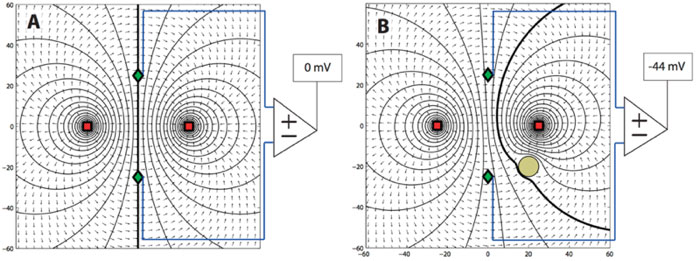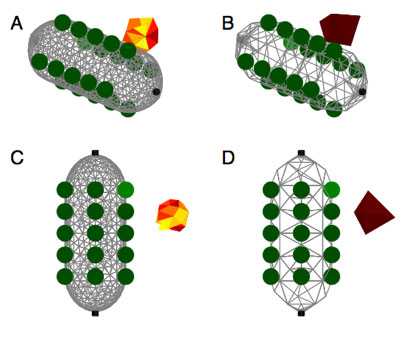Active Electrosense
About
Few effective technologies exist for sensing in dark or murky underwater situations. For this reason, we have been exploring the use of a novel biologically-inspired approach to non-visual sensing based on the detection of perturbations to a self generated electric field. This is used by many species of neotropical nocturnal freshwater fish. This approach, termed active electrosense, provides unique capabilities for sensing of nearby objects.
Northwestern University has pioneered developing electronic equivalents to active electrosense. Together with Fred Boyer's group, we organized the First International Workshop on Robotic Electrosense in 2012.
Fundamentals

The image above provides an example of how this sensory mechanism works. In A, two electrodes (red) are set to emit a bi-phasic oscillating signal. Another two electrodes (green) are positioned orthogonal to the original pair and all electrodes are equidistant from a center point. When the green electrodes are measured differentially in an open space with no objects present, a voltage perturbation of 0 is measured. In B, when we add an object whose conductivity differs from the surrounding fluid, the field is perturbed so that we are able to measure a change in voltage. This system creates the basic unit we use for active electrosense where changes in the conductivity of the environment can be sensed.
The video below demonstrates what happens to the field and electrode measurements as an object flies by an insulating pod.
Exploration
An intutive use for our active electrosensing robot is to explore unknown underwater environments. There are plenty of techniques developed for vision and sonar, however our induced voltage pertubations does not fit either of these categories. Rather than abstracting and correlating the voltage pertubation with specific objects (see Statistical Object Identification) we stay exclusively in the voltage domain. The assumption is that every object will have a particular voltage profile; and thus searching for the areas that are unqiue in each profile will help us localize objects more easily. The question that we ask is how do we optimally maximize our time in the regions that will yield more salient information given that we don't know where our objects are ahead of time. We use Bayesian filters, Fisher information as well as ergodicity to try to answer our question.
Obstacle Avoidance
Simple reactive control algorithms can be applied to the sensorPod to navigate through cluttered underwater environment. Shown below is a point of vision (POV) shot of the sensorPod navigating through a simulated cluttered environment using electrosense. The sensorPod moves autonomously with a single goal to traverse the tank from one end to the other. The VU meter on the side shows the electric signals on the left and right-hand sides of the sensorPod. The sensorPod tries to balance the electric signals on two sides to avoid obstacles.
Capacitive Sensing
For underwater applications in natural environment, the ability to detect live objects is very useful. We have developed a sensor that is able to tell the capacitance of underwater objects. In the demodulation stage, two reference channels 90 degree in phase are used to demodulate the input signal. The DC signals after demodulation are used together to derive the phase shift caused by the capacitive object. In addition, frequency variation is used in capacitive sensing to obtain the Bode plot of a capacitive object. The capacitive sensing module has been proved experimentally to be able to tell the different between animate and inanimate objects. And the derived phase can be used to infer object's nature.
Statistical Object Identification
At any moment, the voltage readings from five sensor pairs of the sensorPod form an electric image of an object presented. Also, when an object flies by the sensorPod, the voltage reading at any sensor pair will form a profile over time. These profiles vary according to the geometry, size, position, distance and orientation of the object in a highly non-linear way. With statistical methods, I am trying to find useful patterns in these electric images and uses them for inferring object's properties.
Object Tracking Using EIT
We have developed a method for localizing and tracking of objects underwater using techniques originally developed as part of Electrical Impedance Tomography (EIT). Frequently this approach has been explored for use in medical applications where electrodes are placed around the thorax of a human body and pairs of electrodes drive small amounts of current through the tissue while other pairs measure changes in electrical potential. The measurement set enables estimation of the conductivity of the space enclosed by the electrodes. In our approach rather than looking at a conductive region "outside in" we use EIT "inside out" to estimate the conductivity of the volume around an underwater mobile sensory platform. These estimates of conductivity enable us to localize and track objects while taking into account the complex electrical lens made by the shape of the sensory platform and the surrounding environment.

The image above provides an example forward model (A, C) and reconstruction (B, D) for a spherical object of conductivity higher than the surrounding fluid. Prescribed currents are driven between pairs of electrodes in the forward model and voltages at other pairs of electrodes are estimated. A second mesh of differing resolution is used for reconstruction. Voltages from the forward simulation stage are used to perform regression, which solves for conductivity, which "explains" the voltages measured.
People
Michael Peshkin
Malcolm A. MacIver
Kevin M. Lynch
Yang Bai
Yonatan Silverman
James Snyder
James Solberg
Sandra Fang
Related Publications
Enhanced detection performance in electrosense through capacitive sensing, Bioinspiration \& Biomimetics, vol. 11, pp. 055001, 2016 Google Scholar PDF
Human-in-the-loop active electrosense, Bioinspiration \& Biomimetics, vol. 12, no. 1, pp. 014001, 12/2016/ 2016 DOI Google Scholar PDF
Finding and identifying simple objects underwater with active electrosense, The International Journal of Robotics Research, 2015 Google Scholar PDF
Improving Object Tracking through Distributed Exploration of an Information Map, IEEE Int. Conf. on Intelligent Robots and Systems (IROS), 2014, 2014 Google Scholar PDF
Biomimetic and bio-inspired robotics in electric fish research, Journal of Experimental Biology, no. 216, pp. 2501-2514, 06/2013/ 2013 DOI Google Scholar PDF
Optimal Planning for Information Acquisition, IROS 2013, 2013 Google Scholar PDF
Sensing Capacitance of Underwater Objects in Bio-inspired Electrosense, IROS 2012, 10/2012/ 2012 Google Scholar
Location and Orientation Estimation with an Electrosensing Robot, IEEE Int. Conf. on Intelligent Robots and Systems (IROS), 2012, 10/2012/ 2012 Google Scholar
Underwater object tracking using electrical impedance tomography, 2012 IEEE/RSJ International Conference on Intelligent Robots and Systems (IROS 2012), Vilamoura-Algarve, Portugal: IEEE, 2012 DOI Google Scholar
Active electrolocation for underwater target localization, The International Journal of Robotics Research, vol. 27, SAGE Publications, pp. 529-548, 2008 Google Scholar
Omnidirectional sensory and motor volumes in electric fish, PLoS biology, vol. 5, Public Library of Science, pp. e301, 2007 DOI Google Scholar
Robotic electrolocation Active underwater target localization with electric fields, Robotics and Automation, 2007 IEEE International Conference on, IEEE, pp. 4879-4886, 2007 Google Scholar
Sensory acquisition in active sensing systems, Journal of Comparative Physiology A: Neuroethology, Sensory, Neural, and Behavioral Physiology, vol. 192, Springer, pp. 573-586, 2006 Google Scholar
Modeling electrosensory and mechanosensory images during the predatory behavior of weakly electric fish, Brain, behavior and evolution, vol. 59, Karger Publishers, pp. 199-210, 2002 Google Scholar
Towards a biorobotic electrosensory system, Autonomous robots, vol. 11, Springer, pp. 263-266, 2001 Google Scholar
Back to top